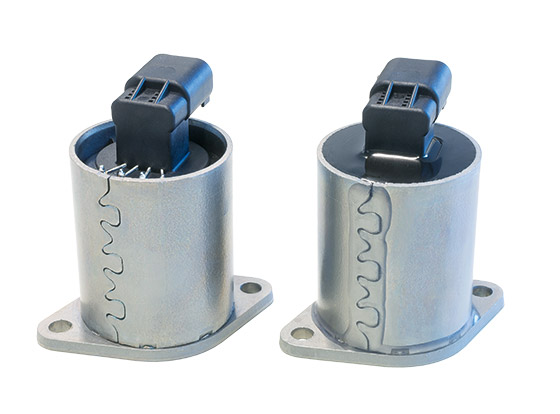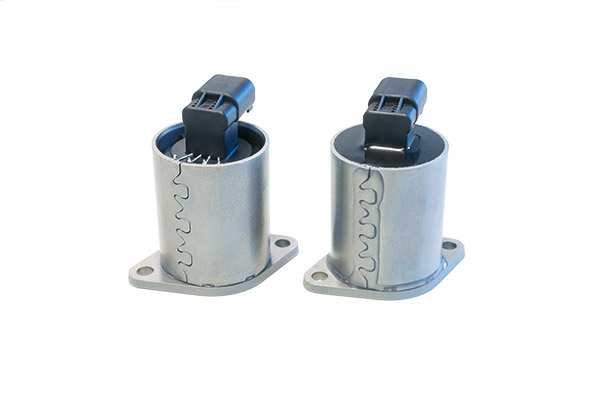Increased driving comfort and safety are important development targets for automotive manufacturers. One approach is to reduce the roll movement when cornering. Rausch & Pausch, one of the leading providers of solutions for driving comfort, uses DELO adhesives for their roll stabilizers.
The integration of mechatronic systems such as controllable air suspension, controlled damping or roll stabilization in the development is playing an ever greater role. Pneumatic and hydraulic valves at central points of the chassis ensure smooth operations. When driving along sharp bends, roll stabilization not only prevents a vehicle from being pressed to the outside of the curve by centrifugal force but also balances stress loads caused by bumps. For example, control valves control the pressure generated by a pump, thus minimizing or completely offsetting roll movements when cornering.
So far, such electro-hydraulic systems have been used mainly in premium vehicles, sports cars and SUVs. Rausch & Pausch GmbH (RAPA), with its headquarters in Selb, Germany, is one of the most important suppliers in this sector. Owing its growth to complete systems for automatic convertible top controls, the family-owned company, founded in 1920, now ranks among the world’s leading developers of hydraulic and pneumatic valve systems. The company has grown to around 900 employees at three sites in Germany and the USA, counts the most important OEMs and system suppliers among its customers and supplies companies like Mercedes-Benz, Porsche and Landrover.
The magnetic head is the control unit and one of the key parts of a roll stabilization system. It drives the control and shift valves that control the oil flow in the system. Depending on the application, up to five magnetic heads per block are used and, depending on the vehicle type, one or two blocks per vehicle are fitted.
Reliable Sealing Required
To ensure permanent compliance of magnetic heads with automotive requirements, RAPA protects two points of the magnetic heads using adhesives or casting compounds. This is done by casting the electronics consisting of a coil and magnets inside the cylinder with two-component room-temperature-curing polyurethane adhesive. This material must exhibit very low viscosity to completely cast the cavities and the gap. However, due to its low viscosity, it would leak from the housing joint and the spot-welded transition joints between the housing and the base plate, and that is why these points of the housing have to be sealed additionally before applying the polyurethane adhesive.
To find a suitable material, RAPA specified the requirements for the subsequent production process at an early stage.
For example, cycle times of less than 10 seconds to the next processing step were called for, thus practically excluding the use of heat-curing products. The adhesive should also feature flow properties suitable for short dispensing times and dispensing paths and permit automation.
Dual-curing Methacrylates – the First Choice
With these requirements in mind, RAPA contacted DELO which proposed using a dual-curing methacrylate. This product group not only enables light curing within seconds and thus direct further processing of the components without intermediate storage for curing or cooling, but also offers the required reliability for automotive applications. Based on the promising results of the laboratory tests, the decision was made relatively quickly in favor of the adhesive DELO-ML DB136. This product can be used within a temperature range of –40 °C and +150 °C and is resistant to engine oils, fuels and gritting salt. In view of the application point close to the underbody of the chassis, it is thus guaranteed that the adhesive does not come off during operation. It also complies with the requirements of the standard IP6K9K required for the sealing of low-viscosity polyurethane castings.
Its second curing mechanism makes it cure under exclusion of oxygen also in shadowed areas where the housing is joined and spot-welded and the adhesive is not reached by light. This is important, not least because of the risk of corrosion that exists when combining uncured material and galvanized steel. In addition to choosing the suitable adhesive, DELO also advised the family-run company RAPA on the integration into the series process and accompanied the tests in cooperation with the plant manufacturer. The process was qualified in such a way, that the first step is to insert the magnetic heads into a mount, while a camera detects their position. The next step is to apply the adhesive from a 600 g cartridge using a fully automated diaphragm valve in combination with an application control by fluorescence if desired. Then the adhesive is cured within less than ten seconds by means of the DELOLUX 80 / 400 LED spot lamp. In the automotive sector, for example, it is common to reserve product innovations, such as driver assistance systems or comfort seats, for the premium segments for a few years only. So it is possible that roll stabilizers will soon also be available in the volume segment. Anyway, thanks to the features such as rapid curing and short cycle times, RAPA is well-equipped to meet rising demands.











